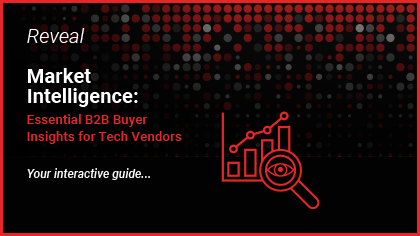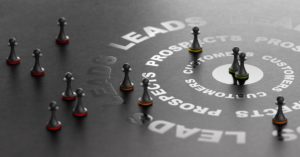B2B sales acceleration strategies are crucial for helping businesses grow revenue through streamlining their sales processes. According to our first-party research, securing a meeting with a key decision-maker often takes about six months for 58% of professionals. What’s more, 78% of sales cycles last 1-12 months. These extended timelines highlight the urgent need to reduce the sales cycle and convert leads into customers more effectively.
How can B2B sales acceleration be achieved? This guide takes a deep dive into 7 tried-and-tested strategies to get your pipeline soaring…
Reading time: 4 minutes
What is sales acceleration?
Sales acceleration is a strategy aimed at winning more deals in less time by speeding up the B2B sales cycle. By effectively shortening your sales cycle, sales acceleration allows businesses to more swiftly convert prospects into customers – thereby achieving sales goals and fostering rapid growth. It is an essential aspect of modern sales, involving a diverse range of disciplines including outbound sales and the implementation of cutting-edge sales tech.
Why does B2B sales acceleration matter?
Sales acceleration offers several substantial benefits for B2B businesses. Here are some key reasons why it should be a priority:
1. Revenue growth and sales goal achievement
The primary objective of sales acceleration is to boost revenue growth and attain sales targets. By optimizing your sales process and leveraging acceleration tools, you can enhance team efficiency and productivity. This, in turn, accelerates revenue generation, elevates sales, and helps meet your business goals.
2. Pipeline anxiety reduction
A well-structured sales process boosts the confidence of sales reps, enabling them to guide prospects through different stages of the sales funnel more efficiently. By employing proven sales strategies, reps can close more deals and reduce pipeline anxiety as a result. This not only improves their commitment to work but also motivates them, enhancing job satisfaction.
3. Improved customer relationships
Deploying sales acceleration tactics such as content personalization fosters better customer relationships by demonstrating to your prospects you understand their problems and are able to provide the right information to help them solve their pain points. Automation is another tactic that can help free up admin time, helping your sales team focus on delivering a more seamless and attentive customer experience needed to accelerate trust and fast track relationships.
7 B2B sales acceleration strategies marketers need to deploy
While we’ve looked at some of the key benefits of sales acceleration, let’s run through 7 proven strategies that will help you navigate the fast lane of B2B sales acceleration:
1. Harnessing data science for B2B sales acceleration
Data science provides an array of tools designed to help businesses better understand their audience and optimize their marketing efforts. Key among these tools are look-a-like modelling, intent data, and propensity modelling.
- Look-a-like modelling with AI and Machine Learning: Look-a-like modelling enables businesses to identify potential customers that share characteristics with their existing customer base. By leveraging AI and machine learning, businesses can recognize patterns and trends that mirror the characteristics of their current customers, helping build a target account list (TAL) for advertising campaigns.
- Leveraging intent data: B2B intent data helps businesses understand who among their target accounts is actively researching for a solution. By mapping target accounts and understanding what topics are spiking, businesses can focus their efforts to engage the audience at the right time.
- The power of propensity modelling: Propensity modelling predicts the next best move and identifies the likelihood of leads, customers, and site visitors performing a specific and desired action. By focusing on engaging prospects with the highest propensity to convert, propensity modelling can boost conversion rates, enhance campaign ROI, and reduce media spend.
2. Account-Based Marketing (ABM): Velocity and penetration
ABM is a highly effective strategy for accelerating the sale pipeline because it allows businesses to target specific high value accounts with tailored messaging designed to resonate with key decision makers. It enhances accuracy, boosts ROI, creates stronger relationships, and provides a greater sense of purpose for metrics and building influence.
For a deeper understanding of the benefits of Account-Based Marketing, explore this insightful article on Top Account-Based Marketing Benefits.
Defining both revenue and non-revenue ABM goals and assigning relevant KPIs is crucial. By tracking key metrics like account engagement rate, opportunity rate, account win rate, target account pipeline, and bookings or revenue, businesses can effectively measure account-based marketing performance. This comprehensive approach allows organizations to gain insights into the success of their ABM campaign and prioritize accounts strategically.
3. The role of Business Development Representatives (BDRs)
BDRs can be crucial in helping speed up the sales cycle and are often the first point of contact for potential customers. They provide one-to-one outreach into selected target accounts to increase account penetration. By reaching out to prospects individually with compelling messaging based on your value proposition you should speed up your go-to-market results.
BDRs can also provide a vital bridge of the gap between sales and marketing efforts, helping to transform MQLs into sales ready leads through delivering a personalized lead follow-up strategy.
BDRs should utilize all available resources to generate engagement with your leads. They can leverage techniques like cold calling, cold emailing, lead generation, research, networking, and social selling to engage and resonate with decision makers in target accounts.
4. Prioritizing lead quality and prioritization
Understanding which high-quality leads to prioritize and those with the greatest propensity to convert is key. Ensuring leads are nurtured and scored correctly before passing them to sales is vital to maintain a high MQL to SQL conversion rate, reducing lead rejections, and keeping sales accelerating. DemandBI provides powerful lead scoring capabilities to analyze and understand buyer behavior in real-time.
Nurture streams help prevent losing lead interest and keep them moving down the funnel through the lengthy B2B sales cycles. The velocity at which businesses are able to convert leads to MQLs, SQLs, and Opportunities, determines the speed of sales acceleration.
5. Utilizing content for B2B sales acceleration
Understanding where your prospect is in the buyer journey means you can serve them relevant content at the right time, in the right formats, across the right channels.
Creating engaging, consistent, and useful content can instantly capture your audience’s attention and increase trust, retention, brand credibility, and reputation. Mapping content against the customer journey ensures you have enough relevant content to push in front of the right people when it matters most to them.
6. Improving sales and marketing alignment
When Marketing and Sales teams unite, great things can happen. Encourage team work, meet regularly, set clear responsibilities, and maintain communication and feedback to help create a unified team.
According to research, companies with aligned Sales and Marketing teams are over two-thirds (67%) more effective at closing deals, generate over 200% revenue growth from marketing tactics, and experience 24% faster revenue growth.
7. The importance of measurement in B2B sales acceleration
Transparent and connected reporting ensures a red thread on every opportunity, enabling improved optimization across your channels and targeting strategies. A single source of truth pulls together different metrics from various reporting tools and platforms to provide a single view, allowing businesses to identify reliable insights and make data-driven decisions that will increase marketing efficiency, and accelerate the B2B sales process.
Ready to supercharge your B2B sales strategies?
B2B sales acceleration is a complex but manageable process that requires a meticulous approach to data science, ABM, BDR strategies, lead prioritization, content creation, sales and marketing alignment, and measurement. By adopting these strategies, businesses can effectively accelerate their B2B sales process, generate high-quality leads, and ultimately drive business success.
Drive sales pipeline velocity: Explore our comprehensive B2B Sales Acceleration Content Hub for expert insights, cutting-edge techniques, and valuable resources.









